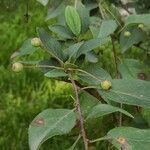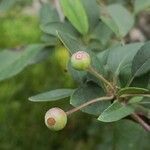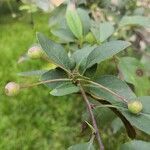Trees to 5 m tall. Branchlets purple or purplish brown, terete, slender, puberulous when young, glabrescent; buds purplish brown, ovoid, glabrous or scales ciliate at margin. Stipules caducous, lanceolate, small, 4–6 mm, membranous, puberulous adaxially, margin glandular denticulate when young, apex acuminate; petiole 0.5–2.5 cm, sparsely pubescent when young, glabrescent; leaf blade dark green and often tinged purple adaxially, ovate, elliptic, or narrowly elliptic, 3.5–8 × 2.5–4.5 cm, glabrous except sometimes puberulous along midvein, base cuneate or subrounded, margin obtusely serrulate, apex long acuminate. Corymb 4–6 cm in diam., 4–6-flowered; bracts caducous, lanceolate, membranous, margin entire, apex acuminate. Pedicel pendulous, purple, 2–4 cm, slender, sparsely pubescent. Flowers 3–3.5 cm diam. Hypanthium glabrous abaxially. Sepals triangular-ovate, 3–5 mm, ca. as long as or slightly shorter than hypanthium, abaxially glabrous, adaxially tomentose, margin entire, apex obtuse. Petals often more than 5, pink, obovate, ca. 1.5 cm, base shortly clawed, apex rounded. Stamens 20–25, unequal, ca. 1/2 as long as petals. Ovary 4-or 5-loculed, with 2 ovules per locule; styles 4 or 5, slightly longer than stamens, long tomentose basally. Pome purplish, pyriform or obovoid, 6–8 mm in diam.; fruiting pedicel 2–4 cm, subglabrous; sepals caducous; with a small scar at apex. Fl. Mar–Apr, fr. Sep–Oct. 2n = 34*, 51*.
A shrub or small tree. It grows 4.5 m high. It is much branched. The stems often intertwine. The leaves are oblong and dark green on the upper surface. The leaves often have purple tints. The flowers hang down on long slender stalks. They are bright red. The fruit are purple.



